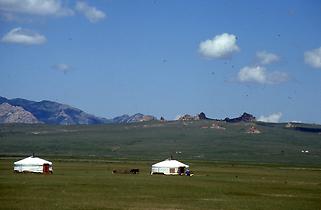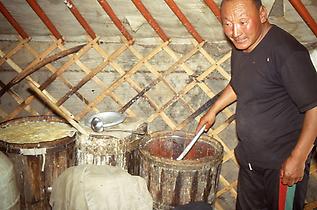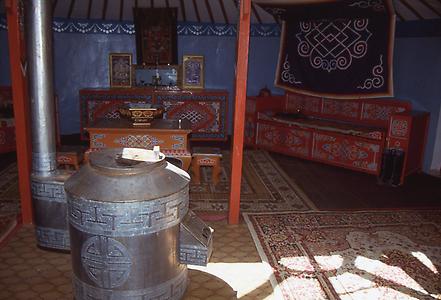Mongolian nomads as they are erecting a yurt#
byYurts are the typical mobile places to live in for the nomadic way of life of central Asian nomads that depend on herds of lifestock. Since sheep play a prominent role it is clear that turning sheep-wool into felt is one of the oldest ways to produce textiles, since it requires no knitting or weaving machinery. Thus, the knowledge of how to produce felt is THE technology that was essential for the development of nomadic cultures in central Asia. The pressing of layers and layers of wool on top of each other to produce felt (mong. äsgij) is still done today. It is the typical work for winter days and produces a hardy material essential for covering their yurts, their "mobile homes".
Originally the word yurt comes from the turk language family. Via Russian it entered the western European languages. In Turkey yurt means "Home" or "Dormitory". Yurts, although constructed in a somewhat different fashion, are also part of the nomadic culture of Kirghiz and Kazakhstani, whose populations also belong to the Turk family. In Mongolia yurts are called ger.
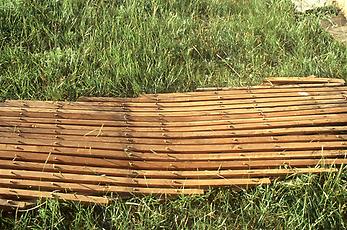


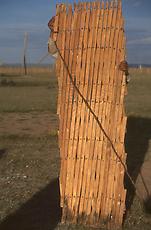
The parts for building a yurt are convenient to handle and to tranport. Although there are still families who use camels or wagons pulled by horses or such, motorized vehicles for transport are starting to be more and more common. Adaption to modern times is evident in many ways. Yet the main principle to move from one pasture ground to the next has not changed. A nomadic Monoglian family moves on traditional routes through "green pastures". It lives by selling high-quality sheep and goat wool. Raising of horses and camels are also important for their livelihood. Statistically, there is one horse per person in Outer Mongolia!



A yurt is a mobile place to live in. It is not anchored to the ground: In that sense it differs from tents: There are no pegs or ropes to fix it to the ground. In earlier times, the interior was just the ground covered by grass. Today mainly wooden boards (mong. chana) are used that are covered by mats and carpets (mong. schirteg). The size of a yurt is determined by the number of frames ("Virgina fences", mong. chana ). Some yurts are quite large as is evident by monasteries in yurts caused by the Russian repression. There are also yurt-hotels with some very substantial yurts where one meets for communal activities and food. The most elaborate yurt belonged to Bogd Kann who was both the religious and political leader with absolut powers before the revolution that was fermented and supported by Soviet communism.
The one person in history to unify all Mongolian tribes, Dschingis Khan, had a luxurious yurt that was transported on a huge wagon pulled by animals. This made travel very convenient. However, Dschingis Khan would always ride himself on a horse like all Mongolians do.
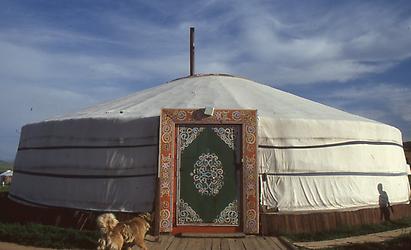






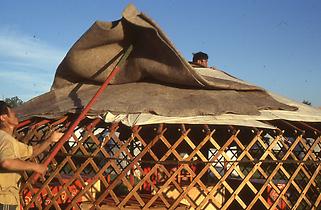

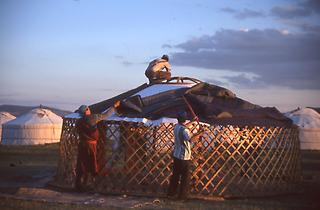





The entrance to a yurt always faces South and often has a wooden door (mog.chaalga), some with impressive ornaments. Such wooden doors have replaced the earlier felt curtains. As first step in building a yurt, when wooden floor is finnished, the frames (mong. chana) are erected. On top of them braces (mong. ounj) to hold the roof are added. They point upward at an angle of 30 degrees and end in a circular roof wreath (mong. toono), that is suported from the inside by two wooden pillars (mong. bagana). To cover this, a thin layer of cotton cloth is added, the basis of a thick layer of felt that provides pleasant inside temperatures both in summer and winter. Today, often a layer of canvas is added. All this is tied together with a kind of rope (mong. buslour), traditionally made of guts and sinews. Now the yurt is stable. The bottom part of the felt covering the yurt (mong. geriin chajaa) can be raised to regulate the temperature inside. There is even room for a small patch to grow herbs. Sometimes yurts are also decorated on the outside with pieces of fabric.
In the middle of the yurt there is a metal stove, fired with dried dung or wood if a forest is nearby. In earlier times an open fire on an iron grate was used. Over this a kettle is suspended (mong. togoo). A stove pipe leads the smoke to the top of the yurt where there is a suitable opening that can be closed or opened. There is also a sturdy rope coming from the top, used to pull it down with force in case of a storm. Criss-crossing ropes are also found in a yurt used for drying meat, to keep it from perishing when later needed for cooking a nourishing soup. Those pieces of meat are responsible for the myth that Mongolians under Dschingis Khan had meat under their saddles to soften it.
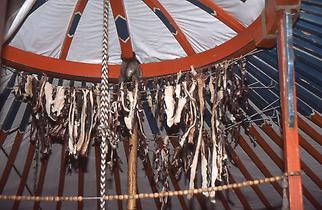

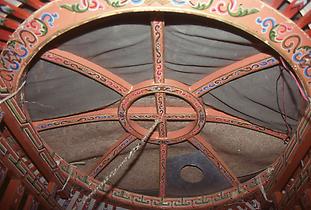


Photo: G. Jontes, under CC BY 4.0

Now the yurt is ready for the family to move in. It is used for living, cooking, working and sleeping. There is a strict rule how space in the yurt is to be used. On the left is the place for the men, on the right for women and children. The place of honor (mong. choimor) for the old and for guests is exactly opposite the entrance in the back. This is also where a wooden chest (mong. awdar) is located, often nicely decorated. It is used to store kitchen utensils, plates, etc. and also food. On it, family photos, pictures of buddhist gods, and many other small things are kept.
On both sides of the yurt wooden blankets are used during the nights. Directly to the left of the entrance is a large leather pouch to collect the milk of mares. A special fermentation process turns this into a lightly alcoholic beverage, the "horsewine" (mong. Airag).
Mongolian nomads practize an impressive and honest hospitality. If a newcomer wants to enter a yurt it is wise, to get attention, to shout "hold the dog" (mong. nochoi chor), since the mongolian herding dogs are not used to play but are trained to watch over their herds and strangers. After this, one enters the yurt, making sure to use the right foot first without touching the doorstep. The women of the yurt will now offer a tablet with home-made milk based delicacies, like cheese (mong. bjaslag), sour creme (mong. öröm), cotton cheese (mong. aartz) and a cup of Airag. Before starting to drink a few drops are sprinkled for the gods. It is improper to keep standing for more than this, and nobody should walk to the back passing between the two supporting pillars mentioned.
One will be guided to the place of honor, sits down, and starts to explain where one comes from and whereto one plans to continue. The children will listen full of curiosity, and the cup with Airag starts to move from person to person. A bit of schnaps (mong. archi) will further improve the atmosphere.
